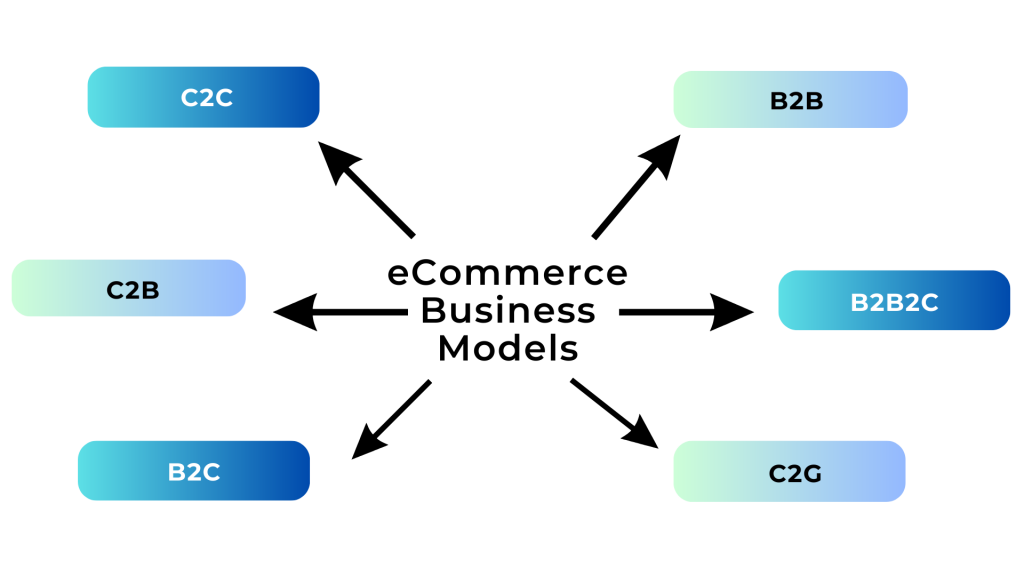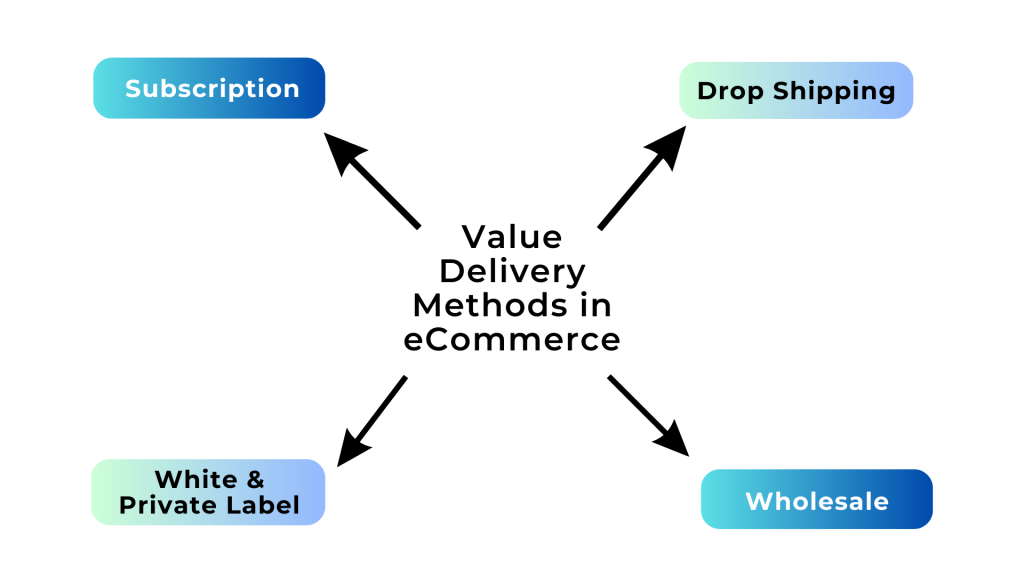There are countless opportunities for entrepreneurs willing to take risks and start their own businesses. However, operating a business is not that straightforward. It needs profound knowledge for companies to utilize the potential of their resources. Identifying your business model is important for anyone trying to establish an eCommerce business since it helps you successfully direct your branding and plan marketing efforts. Today, we’ll provide a high-level summary of the various eCommerce business models to consider when launching your business so that you can make the best selections possible straight away.

What is an eCommerce Business Model?
Both new and established businesses need strong business models. By spotting growth prospects, they assist businesses in understanding their clients, retaining personnel, luring investors, and supplying a lasting competitive advantage. The phrase “business model” refers to a company’s fundamental strategy for making a profit and offering consumers value. The characteristics of a strong business model describe the customer value proposition and pricing strategy. It pinpoints the goods and services of a target audience, business services, and foreseeable costs.
Online Store Preferences
The appeal of online shops is strikingly more diverse than the store-front shops that most consumers have been used to. Understanding this trend can aid in providing more numbers for eCommerce stores that are just starting out. On the other hand, for established businesses, like B2B brands, it’s also vital to consider what consumers prefer to reach them more effectively. When thinking about the availability of brands online, B2B and B2C markets have access to purchasing products and services through all hours of the day, on any day of the week. This makes room for more convenience for consumers to shop and check out items from sellers.
Digital Wallets are Dominating Global eCommerce
Throughout the pandemic in 2019, digital wallets have made it into the system of daily transactions. To this day, digital wallets are dominating about 49% of eCommerce payments worldwide. It’s projected that the eCommerce market share will reach up to 53% in 2025. This trend is made more fundamental by eCommerce platforms that have paved the way for consumers to transact business and purchase items online.
With more people using the internet to work and connect, eCommerce platforms and digital wallets are growing exponentially. The rising adoption of technology across most means of communication and engagement has shifted the industry toward a more tech-driven perspective. More channels for digital wallets mean more opportunities for businesses to work on their transactions seamlessly.
Availability of Reviews
The statistics of Business Trustpilot pointed out that 9 out of 10 consumers conduct research and consult reviews before purchasing. Both B2B and B2C markets were seen to conduct personal research before purchasing any product or service. Nearly 88% of consumers across the globe make an effort to check on a product or service’s reviews before purchasing. This is particularly important for startup businesses that are looking to raise their numbers and expand their brand awareness. Investing in opportunities where consumers can review their purchased products or services will aid in creating more consistent purchases
With reviews in the picture, consumers also look for the authenticity of reviews. Based on the study conducted by Trustpilot, 62% of consumers will not support brands that engage in auto-generated and filtered reviews. Some brands place auto-generated reviews on their website to obtain more customer purchases. Statistics show that consumers for both B2B and B2C do not tolerate fraudulent reviews and claim that these reviews should be removed.
E-commerce Platforms Are on the Rise
Hovering over the fact that more and more businesses are moving online, business-to-business transactions have also gained the spotlight. Since countless consumers have online accounts, businesses are now operating their business transactions online as well. Companies of different sizes, from small businesses to large conglomerate enterprises, are adapting to business-to-business eCommerce.
Based on the research of Digital Commerce 360, the B2B marketplace alone is said to reach $3.6 trillion in the next three years. Considering the number of consumers for businesses-to-business and business-to-consumer marketplaces, the eCommerce industry for both parties has rising forecasts. These positive traits are accompanied by an extensive amount of brand awareness and marketing through different social media platforms and media channels, such as Google Advertising and website posts.
E-Commerce statistics are crucial for any business to determine growth, challenges, and goals. These pieces of information allow a business to make better decisions when planning and developing its strategies. Since the population of consumers is growing significantly, the evolution of eCommerce businesses is encouraged to adapt to consumer behaviors and technological advancements.
Types of eCommerce Business Models

Consumer-to-Consumer (C2C)
A customer selling a good or service to another consumer is known as a consumer-to-consumer business model. As in the case of selling a pre-owned laptop on Facebook Marketplace. Individual sellers frequently start out on online marketplaces, then launch an online store to establish a name and increase sales.
Benefits
- Minimal Costs
- Efficient for Small-time Sellers and Buyers
- Higher Margins and Lower Prices
Consumer-to-Business (C2B)
The C2B business strategy entails selling your products, services, or other offerings to other businesses. Because it enables them to sell their services to a bigger market, this program is a great option for freelancers or those who operate from home.
Benefits
- Better Customer Loyalty
- Affordable Advertisements
- Higher Revenue
Business-to-Consumer (B2C)
Commerce between a company and a single consumer is referred to as a “business-to-consumer” (B2C) business. For instance, when you purchase a piece of apparel from an online shop. This comprises traditional brick-and-mortar businesses, but it has also evolved to mean online shopping, sometimes known as e-tailing.
Benefits
- Unique Products and Services Offered
- Lower Costs
- Better Branding
Business-to-Business (B2B)
Any trade between two firms is referred to as business-to-business (B2B). Compared to businesses that sell at the retail level, wholesale retailers often come under this category. As a retailer, brands can also incorporate business-to-business goods. For instance, a coffee company may sell its beans in bulk to coffee cafes in addition to consumers on its website (B2C).
Benefits
- Established Corporate Buyers
- Single-Platform Usage
- Direct Business Transactions
Business-to-Business-to-Consumer (B2B2C)
B2B2C is a strategy that relies on employing an intermediary to bring a brand’s items to a consumer. Because they require middlemen that serve as a gathering place for companies selling comparable goods, middleman shops like Sports Central are able to optimize the sales potential of their items.
Benefits
- Direct Products or Services from Manufacturers
- Multi-Faceted Consumer Experience
- Double Variety
Customer-to-Government (C2G)
Another common eCommerce business model that incorporates both people and the government is called customer-to-government (C2G) or customer-to-government (C2A).
Benefits
- Access to Governmental Services
- Flexible Public Administration System
- Public Promotion
What are Value Delivery Methods in eCommerce?

Subscription Method
Every sector now offers various subscription services to provide convenience and savings to its clients in this highly technologically evolved age. This type of method in eCommerce allows buyers and sellers to acquire goods and services through one line of subscription. While subscription plans may differ from one brand to another, there are countless offers that can cater to different business sizes.
White and Private Label
When employing private labels, a store develops a special product for them to sell only by contracting a manufacturer or producing it themselves. Both white labeling and private labeling can help you minimize costs on manufacturing and design expenses while pursuing a technological and marketing edge.
Drop Shipping
One of the eCommerce strategies with the quickest growth and most efficiency is drop shipping. The majority of drop shippers market products that are supplied by a different provider. Drop shippers often serve as an intermediary between customers and manufacturers. Users may connect inventory from suppliers all across the world for their stores using simple tools.
Wholesale
In a wholesaling strategy, the store provides goods in bulk at a reduced cost. Although wholesale was historically a B2B idea, many shops now provide it to price-conscious consumers in a B2C setting. In wholesale stores, buyers can get goods and services at lower costs per unit when buying in bulk. This makes costing for their individual businesses more efficient as they can acquire more goods or services at cheaper prices.

Now that you’ve read through this article, you should have a good idea of the types of eCommerce business models that you can use. As with any business, it’s important to understand what your goals are before making a decision. In the eCommerce ecosystem, it is vital to understand which business model best suits your company goals and product or service offerings. As you go about identifying how you will conduct your business strategies, ensure that you are familiar with the way you intend your business will be directed.
You can start your business with a trusted platform too. Especially for Business-to-Business companies, you can start connecting with the country’s leading brands to showcase your products and services. Find your solutions at Shoppable Business, the country’s next-generation eCommerce B2B platform! Whether you are a seller or a buyer, you’re welcome to join!









